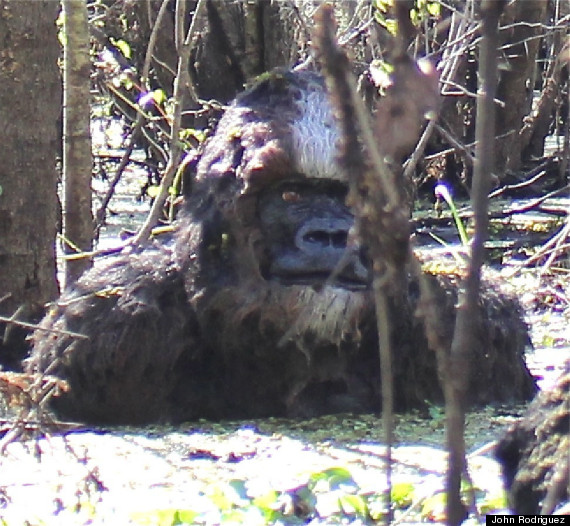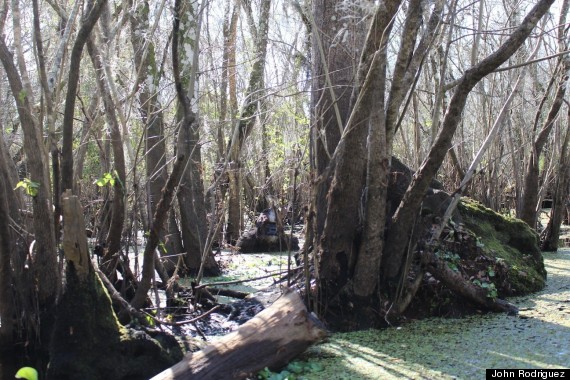One occupational hazard of reporting on unexplained phenomena: You can always count on waking up in the morning to find an email from someone swearing that they've just seen Bigfoot, the Loch Ness Monster, a hybrid human alien or a UFO on the moon.
2015 began with a photo from John Rodriguez, a 66-year-old retired electrician, who claims that he was fishing Dec. 26 on the Hillsborough River near northeast Tampa, Florida, and came upon an incredible sight.
"I fish for gar in the river and I bring my camera to take pictures of the birds and what not. I heard a squishing sound, looked over and saw this thing walking through the water and crouch down in the duck weed. It did not look like a guy in a suit -- it was definitely an animal. I took this picture and got out of there as fast as I could."
Here's the image that Rodriguez sent to HuffPost:
Rodriguez claims to have seen and photographed -- in a completely clear and non-blurry moment -- that tall, hairy, elusive creature often reported in North America and other parts of the world that goes by many names: Bigfoot, Sasquatch, Yeti. In Florida, it's known as the Swamp Ape or Skunk Ape (primarily from descriptions of an extremely pungent odor it supposedly gives off).
"I've heard of Skunk Ape prints around Green Swamp [in Florida], but never anything like this," Rodriguez told HuffPost in an email. "My whole life, never seen anything like it."
Of course, the fact that the photo looks a little too crisp at some points, made us suspect it to be a fraud. Just look at the jagged line between the hairy beast and the water. That could be the work of a novice who just downloaded Photoshop for the first time.
However, we've got some time to kill. And doesn't this man deserve to be taken at his word? After all, wouldn't finding Bigfoot be a great way to kick off 2015?
Rodriguez said he snapped the picture in the early afternoon at an area where the Hillsborough River becomes a cypress swamp. The map below shows a small section of the 59-mile-long river that flows through Florida, filled with wildlife preserves that include many not-so-friendly creatures, such as alligators, known to jump into canoes and
attack unsuspecting humans.
So, what are we to make of this fantastic tale? Did Rodriguez take the clearest, most definitive picture to date of Bigfoot?
Not so fast, according to
Ben Hansen, lead investigator of the Syfy Channel's "Fact or Faked: Paranormal Files" series.
"It's a relief to finally have a clear picture of the creature," Hansen, a former FBI agent, told HuffPost. "Every other photo and video we get is usually too blurry or the Bigfoot too obscured in brush to allow for any useful identification. Thanks to the clear photo, I'm excited to announce that the photographer has captured a real-life... gorilla in a Bigfoot suit!"
"To be more precise, the face of a gorilla that has been digitally added to the photo with editing software. Although I originally suspected the creature suit was actually in the water when the photo was taken, I started to notice shadows in front of the Bigfoot that appeared to be an inconsistent length and shape with the rest of the photo."
"Additionally, there appears to be some heavy digital editing touch-up to the fur around the face and where the body meets the water. I'm now leaning more toward believing the whole creature was pasted into the image and then branches and twigs were added in the foreground. The branches also could have really been in the scene, but they were later edited as separate layers so Bigfoot looks like he's now behind them, sitting in deep contemplation."
Digital photographs use a format called
EXIF data, which stores a lot of accessible information within each image -- like shutter speed, if a flash was used, date and time of the image, etc. Hansen pointed out that the EXIF information of the Florida swamp creature picture suggests the image was digitally created on Dec. 26 with Photoshop.
Since those details are extremely important when trying to research unexplained phenomena images, we asked Rodriguez about this.
"I did not Photoshop this at all. Believe me or not," Rodriguez said. "When I plug in my memory card, it asks to import and opens in Photoshop. I just changed the name and saved. It seems like people get publicly crucified for coming forward with this kind of stuff."
Rodriguez also said this debunking attitude is what caused him to initially hesitate sending the original picture to HuffPost.
The belief in mythological animals might be as old as humanity itself. Nearly every culture's folklore contains at least one imagined creature in its folklore that has no place in modern science.
It's easy to imagine how, in the days when much of the planet had yet to be explored and catalogued, you might have reasonably believed in the existence of any of these beasts. But in the present day, when every square mile of the earth's surface has been photographed by satellites, and scientists have identified 1.3 million species (with mostly plants, tiny animals and microbes remaining to be found), how could you still believe in a lumbering, seven-foot-tall ape, hiding out in one of the most well-studied countries on the planet?
When dealing with reports and discussions about things like Bigfoot, UFOs, lake monsters, ghosts, etc., there's always a fine line walked by those who make the claims and the skeptics or outright debunkers who do their best to make the stories go away.
In the most literal sense, that's the nature of the beast -- especially where large, hairy creatures are involved.
Hansen brings up another item about this current alleged Skunk Ape sighting near Tampa.
"The white stripe down the middle of the head and chin is a nice touch. If it's a Skunk Ape, why not make it look like a skunk, right? In reality, I have yet to come across a story with any merit where witnesses describe the Skunk Ape with an actual white stripe like a skunk."
Par for the course, these stories produce strong opposing points of view. And still, one clear photograph of something that may or may not be a real Bigfoot is not definitive proof that the creature exists, the way DNA evidence -- or an actual body -- would be.
lee.speigel@huffingtonpost.comEm






